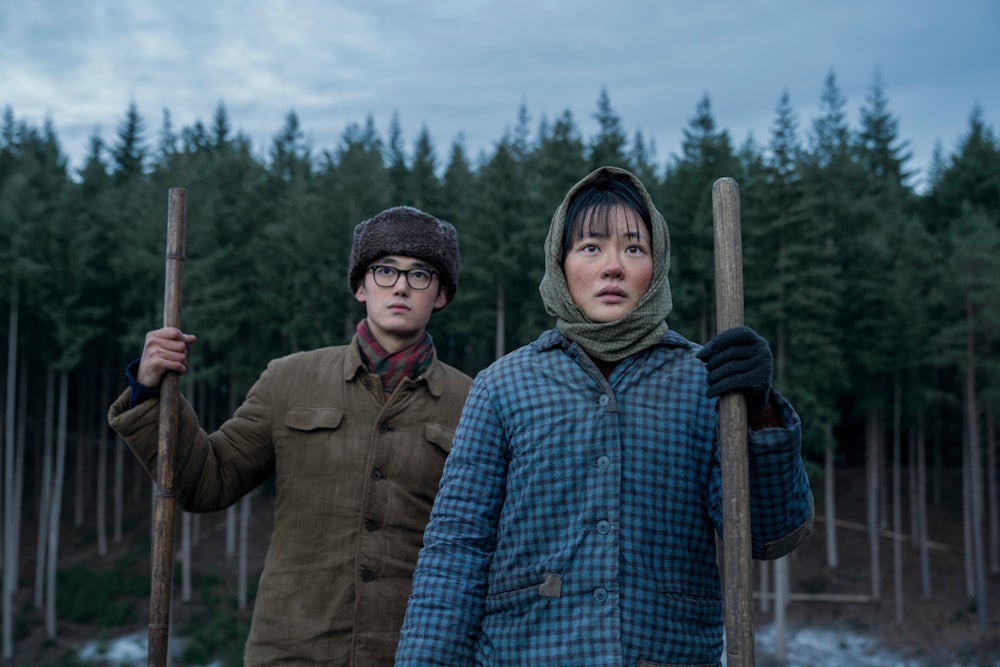“Our goal is nothing less than the reinvention of the science fiction television series.” This is the opening line of one of my favorite documents of twenty-first-century television: the series bible that Ronald D. Moore wrote for his 2004 reboot of Battlestar Galactica. A reference guide for details about characters and plot arcs, the BSG bible also lays out the show’s visual style, with its signature use of handheld cameras, practical lighting, and extended takes. It stipulates that every visual effects shot will be grounded in an almost documentary style; whenever there’s an image of a spacecraft shooting through the stars, the viewer should be able to imagine where in the world of the show the shot is coming from. Is the camera in a separate spaceship? Is it mounted on the wing? “The battlestar Galactica,” he writes, “should on every level feel like a real place.” Not every sci-fi series or film to come after BSG follows this model, but it’s easy to spot the principles of what Moore called “naturalistic science fiction” in everything from the MCU to the Star Wars universe itself.
I thought of Battlestar Galactica more than once as I watched Netflix’s new, big-budget sci-fi epic, 3 Body Problem. Developed by Game of Thrones stewards David Benioff and D.B. Weiss, alongside The Terror: Infamy co-creator Alexander Woo, 3 Body Problem is brisk and competent TV. It does a smart job curating and condensing the labyrinthine narrative and heady science of Liu Cixin’s bestselling novels, and it balances intimate human drama alongside some spectacular set pieces: There’s the agonizing unrequited love between two old friends and there are alien humanoids who shrivel up into rolls of parchment in the intense heat of their sun, there are tales of squandered ambition that will make you feel the familiar tug of regret and there’s a big bloody caper in the Panama Canal that will make you want to throw up, laugh hysterically, or both.
These are precisely the kinds layered crises that
animated Battlestar Galactica, but that’s not why the
show came to mind as I watched. Instead, 3 Body Problem made me
think about Battlestar Galactica and its
signature style because I’m not sure 3 Body Problem has one.
TV style can range from showy to subtle, pretentious to programmatic, but the
visual choices TV creators make give these shows their personality, their
distinct point of view. 3 Body Problem is the
streaming event of the new year so far, Netflix’s prized property, coming from
two writers who loomed large over a decade of TV. The show should be a
celebration, a statement, a home run swing, and its narrative architecture
reflects that ambition. Instead, its style is anonymous, ancillary, the work of a
corporate author rather than an artistic intelligence. At a moment of great
change in the television landscape, Ron Moore outlined a vision to reinvent
science fiction. This is a moment of great change for television, too, but,
watching 3 Body Problem, I’m not quite sure what
the vision is.
3 Body Problem is the long-awaited English-language television adaptation of Liu’s globally acclaimed trilogy of novels, The Remembrance of Earths Past. (A Chinese series adaptation of the first book aired earlier last year.) The plot of the series is both incredibly complex and relatively straightforward. In the years after the Cultural Revolution, a Chinese scientist named Ye Wenjie (Zine Tseng), working at a remote antenna in Mongolia, sends out messages in the search for extraterrestrial life. Eventually, one of these messages is returned by an alien on a far-off planet, but Dr. Ye is the only one in the room to receive it. The alien, a pacifist, warns her that Earth mustn’t reply to their message or else that alien’s civilization will get on their ships, come to Earth, and conquer the planet. Ye Wenjie, justifiably bitter after her father had been murdered years earlier in a struggle session, replies anyway. Come and get us.
A majority of 3 Body Problem’s action takes place 50 years later, in the present day. So these scenes in the 1960s and 1970s function as flashbacks, but they are also the best scenes in the show. This is partially because Tseng’s performance is easily the strongest in the series, but it’s also because it’s clear the filmmakers have given these portions of the show a distinctive look and feel to connote them as flashbacks. Vast denuded forests, new construction that already feels like it’s about to rust, the too-bright sun making the very air of cold hallways visible—it’s a tremendously compelling world, raw, sad, even darkly funny.
But back in the present, things are bland and anxious. Ye Wenjie’s globally suicidal invitation remains a secret, but the aliens are already running a covert, long-distance counterinsurgency against the unsuspecting Earthlings. What that means, most specifically, is that scientific readings across the planet are being garbled and disrupted, brilliant scientists are being menaced by foreboding visions, and physicists are inexplicably killing themselves en masse. Our entry points into this chaotic landscape are an ex-MI5 investigator looking into the scientists’ deaths, his shadowy, well-funded employer, and a group of young scientists—“The Oxford Five”—who lost touch after college but come back together as the result of an unexpected tragedy.
It’s easy to forget that much of the first season of Benioff and Weiss’ Game of Thrones was structured as a detective serial, with Ned Stark the private eye trying to solve a murder and unwittingly stumbling into a conspiracy. 3 Body Problem shares that format initially, economically introducing us to our cast of characters as surveillance subjects and suspects. But, once the show gets up and running, it diverges from this hard-boiled approach, and much of the season takes on the feeling of The Big Chill, a nostalgic hangout show in which a group of former college chums and lovers have to reckon with the roles they’ll all play in the coming end of the world.
3 Body Problem is neither as funny nor, somehow, as insightful about the apocalypse as The Big Chill was, but these scenes—many set in a melancholy, picturesque beach house on the English shore—lend a warmth and intimacy to a story that sorely needs it. Not only does the show feel cold because of the unfolding existential crisis it traces; it also needs that human intimacy because nearly all the other scenes in its early episodes take place in a video game.
One common thread among many of the dead scientists is that they appear to have been playing the same sophisticated, mysterious virtual reality game in the lead-up to their deaths. Millions of Twitch streamers might disagree, but there are few spectator experiences more soul-deadening than watching somebody else play a video game. For Jin (Jess Hong) and Jack (John Bradley)—the two players we most frequently watch in game play—the stakes are high and the environment startlingly real. But, for us, the opposite is true.
It’s clear the writers of 3 Body Problem believe these scenes to be real showpieces, parading around different historical costumes, bizarre astrological formations, and incredible ancient buildings. We learn important information in them, but these extended sequences transpire like gussied-up exposition dumps set in landscapes that look like knockoff versions of the spectacular sets and CGI landscapes of, say, Game of Thrones or Foundation. To some extent, the animations in the game need to feel uncanny. We have to differentiate them from the reality of the show, but we also have to believe that the characters themselves can’t differentiate them from their own realities. It’s a tricky predicament for the show to figure out—what does The Real look like?—but it’s a problem they’ve largely deferred. And the visual blankness, the frictionless animated splendor of the game, seeps into the rest of the series. In the game and out of it, the visual effects on this show—many of which are meant to be literally global spectacles of shock and awe—have the chintzy sheen of the Sci-Fi Channel space operas Moore was writing against in 2003. Sights meant to elicit gasps from our characters look like demo reels from startup VFX companies, at best, and demo reels from defense contractors at worst.
One thing we learn early on about the aliens is
that they cannot lie. Because they can’t lie like humans do, they also can
neither produce nor understand fiction. They have a complete multidimensional
understanding of the universe, but they cannot fancy it otherwise than it is. They
demonstrate technical capability but no real imagination. All content, no
style.
Often, when style comes up in terms of contemporary television, it’s about style as a problem. Or, more specifically, it’s about a certain bland uniformity of style that testifies to both the pretension and cheapness of the Peak TV environment. Networks and streamers want shows to look “good,” but that designation is less about quality or imaginative production design than it is about a set of visual tropes that read to well-trained viewers as “good.” (M.C. Mah recently wrote that the ultimate goal of Peak TV was to “annihilate all taste, good and bad.”) Think of the Instagram filter aesthetics of Ozark, the dark and oversaturated “Netflix look” of The Sandman, the tinned Fincherisms of A Murder at the End of the World—Peak TV prestige style can be a copy or a caricature of itself, but it’s also a wan reflection of beloved texts of the prior age. Aping the signature look of Breaking Bad or Game of Thrones or True Detective is a way to activate a set of coded cues for viewers to notice and approve. Such a style distracts distractible viewers from the thinness or derivativeness of the show they’re watching. If it didn’t look like that, they wouldn’t care, or worse, they wouldn’t feel that they should care.
But if style is how these disparate shows conform to the aesthetic of prestige, it can also be how they differentiate themselves from it. Many of the most acclaimed series of the past few years have been distinguished by their singular televisual styles. The Bear’s fast cuts and extreme close-ups sutured to dad rock deep cuts of the mid-aughts; Shogun’s anamorphic lenses and natural light and swirly bokeh—or blur—around the edges; Succession’s nauseating handheld and gray landscapes; I’m a Virgo’s ramshackle practical effects and forced perspective; Euphoria’s loud and hallucinatory “emotional realism.” Not every TV series has to make such bold, conspicuous stylistic choices in order to be successful, of course, and not all shows with a bold, conspicuous style live up to it. But, even in the midst of this post-boom fallow era that Sam Adams called “trough TV,” the best series have had style to spare.
3 Body Problem feels allergic to this kind of cohesive televisual vision. There’s so much to do, so many characters to introduce, so much science to condense and explain, so many mysteries to investigate and unveil, so many questions to ask and answers to complicate, so much book to dutifully adapt. In the moments when we notice the show making a visual or a stylistic choice, they tend to be strictly utilitarian: The scenes in Mongolia mark a transition in time, nearly every pop music cue thuddingly references what’s happening onscreen, two eyes merge into one inside the headset when the video game begins, the capillaries in one scientist’s eyeballs seize into a glowing, ticking clock that warps and deranges everything she (and we) sees. Because these scattered touches nearly all denote transitions out of the show’s present or serve to emphasize points or themes within it, that means that the show’s baseline is a kind of deliberate stylelessness, a boilerplate reality.
The TV landscape is threatened by A.I., by bland uniformity, by rote repetitions of valuable I.P., by the bulk discount aesthetics of that “Netflix look,” but shows that flaunt their idiosyncratic vision, that feel handmade even in their missteps, that have an author plainly behind them, give us the feeling that there might be something on the other side of all this. And this is why it’s so disappointing to see 3 Body Problem, a series with seemingly infinite resources and runway, so uninterested in getting us to watch through any means other than its meticulously translated and transposed story.
Benioff,
Weiss, and Woo have made a show about what happens when humanity itself is at
risk. Do the people of Earth double down on what makes them human, or do they
choose to sacrifice their humanity to save the planet? But when the humanity of
an art form is at stake, it’s puzzling that some of its biggest and most
trusted stewards seem so willing to give it away onscreen. This show, for all
its many fine performances and thoughtful narrative contraptions, feels
processed, not created; professionally managed, not imagined. 3 Body Problem
didn’t have to save TV, but it didn’t have to give up this easily either.






